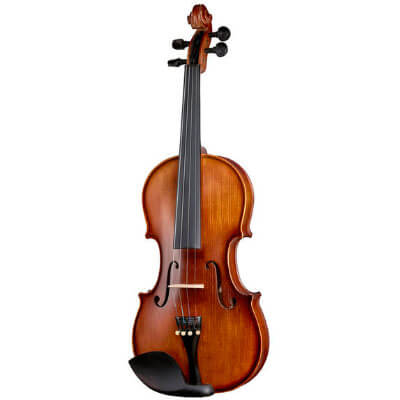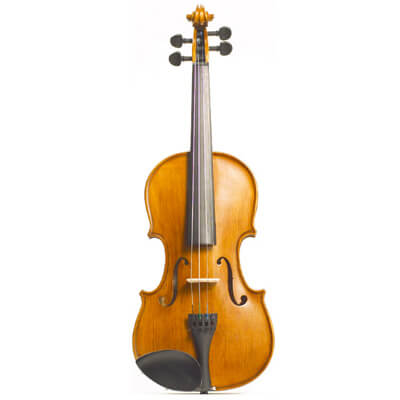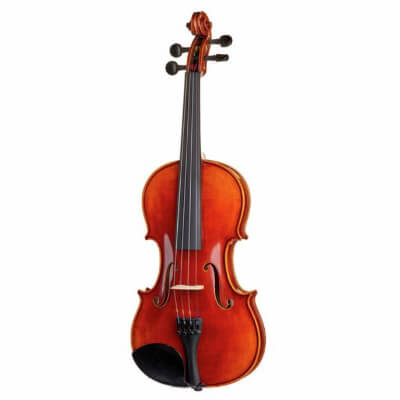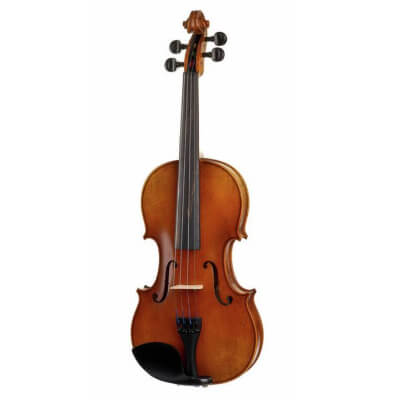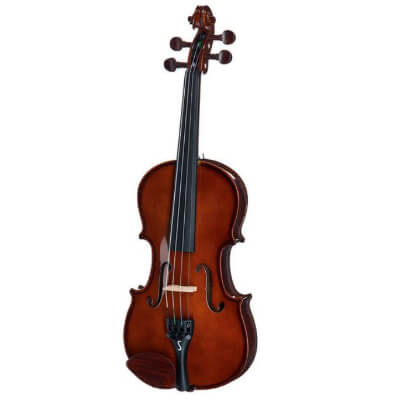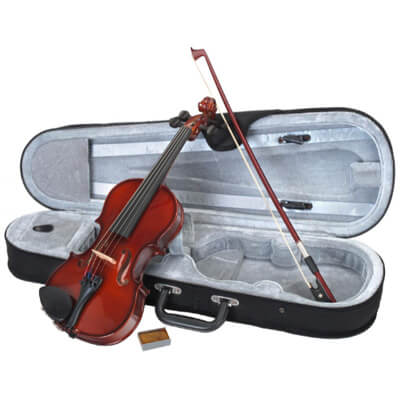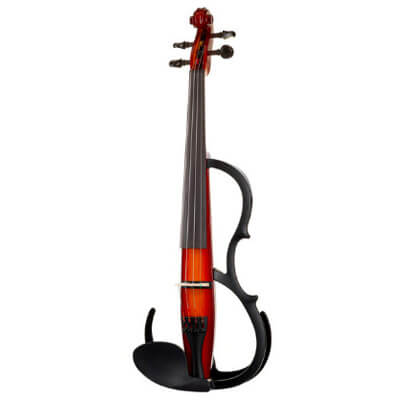Buying a violin: My 7 best recommendations 2025
How to find the best violin for you! No matter if you are looking for a violin for beginners, advanced players or kids. My recommendations show you which violin is suitable for you and what you should consider before buying.
This text has been translated into English. Please report spelling mistakes to sebastian@musiksocke.com
What kind of violin are you looking for?
Frequently asked questions:
Violin for beginners
Beginners want to get started immediately and try out how it feels to play this wonderful instrument. It is therefore advisable to buy a complete set. In addition to the instrument itself, you also need a bow, a safe place to transport and store it, good strings and care products.
As with all stringed instruments, violins come in different sizes. These sizes are usually given as fractions, with differences of about 6 per cent. Teachers recommend that all fingers should enclose the scroll when the hand is outstretched. The standard size is 4/4 and is correct for most adults.
A good violin for beginners is the Thomann Student Violin Set 4/4, which includes a fibreglass bow, a matching case and a rosin for care. The price-performance ratio of this violin is good. The violin is of high quality and has a pleasant and warm sound. The bow is rather average, but sufficient for the first few hours of practice. In my opinion, the best complete set in this price range.
The Stentor SR1500 4/4 Student II Violin set is an affordable set for students and also good for a start. Besides the instrument, a bow, case and rosin are included. The bow is made of wood and covered with real horse hair. The violin has the usual high quality of the Stentor brand and produces a full sound across the entire tonal spectrum. As is usual with affordable violins, the violin quickly goes out of tune and needs to be retuned frequently. However, this is not so bad for beginners and therefore this violin set can also be used for a start.
Violin for advanced players
Those who have been playing the violin for a long time naturally have higher and often very individual demands on their instrument. Because both have a soul. The instrument, as well as the person playing it. Often it is things that look like trifles, but are of great importance to the musician.
A high-quality violin for advanced players is the Yamaha V7 SG44 4/4. The difference to cheaper violins is immediately noticeable when you play it: The sound is warm and voluminous. This is caused by selected woods and the matching D’Addario Helicore strings. The violin is tuning stable and can be easily fine-tuned. It is a set with a bow, rosin and case.
The Höfner Allegro 4/4 Violin Outfit is a set for advanced players with an excellent violin. Besides that, a case, bow made of Mongolian horsehair, chinrest & rosin are included. The strings are very playable and in combination with the instrument and bow a soft and warm tone is produced. The chinrest could be a bit more comfortable, but you get used to it. All in all, a high-quality violin set.
Violin for kids
When you think of kids and music, the violin inevitably comes to mind. No wonder because how many outstanding violin soloists are there who started playing this instrument as children?
Fortunately, violins come in different sizes. The largest are 4/4 violins, the smallest 1/32. The regular 4/4 violin can often be easily mastered by kids from the age of 10. The small 1/16 violins are something for small kids from about 4 years on.
Even with kids, the violin needs to be tested extensively. Online shops offer a right of return for this purpose. Parents often ask me whether a second-hand violin makes sense. Certainly, there are models restored by master craftsmen that have a very special sound. But most of these violins are also very expensive. In addition, violins may have been damaged over the decades. If you want to be on the safe side, you should go for a new model with a sufficient guarantee.
A good violin for kids is the Stentor SR1400 Violin Set 1/4. Kids can start practising right away because the set includes a simple bow, matching case and rosin. The 1/4 size is often used for kids and is suitable for an arm length of 44 to 50 cm. The sound of the violin is precise and pleasant. The bow leaves something to be desired, but is sufficient for the first test of a new hobby. In the long run, however, you will have to buy a higher quality bow that will get more sound out of the instrument.
The Classic Cantabile Student Violin Set 3/4 is an affordable set that is suitable as a first violin for kids with an arm length of 56 to 58 cm. It is a fully-fledged instrument, so that if you like it, switching to a slightly larger violin for adults is no problem. The violin produces a surprisingly loud and rather bright sound. At this price, however, you have to accept a reduction in the bow. However, the included bow is sufficient for the first few weeks.
Violin for crazy people
Those who play very well and have the necessary money will find a huge selection of first-class and exclusive instruments on the violin market. But collectors of beautiful musical instruments can also help themselves to their heart’s content here. Because violins not only sound beautiful, they are beautiful too!
A really crazy violin is the Yamaha SV-250 Silent Violin. It is an electric instrument that immediately catches the eye. Due to the built-in pickups, there is no need for a sound resonator and therefore electric violins have a completely different design than acoustic instruments. The SV-250 is one of the best electric violins and has no difference in feel and sound to a high-priced acoustic instrument.
How do I recognize a good violin?
Let’s start with the less important: the appearance. Time and again you find violins that look very good but are of inferior quality. There is always the danger of being dazzled!
Much more important are good playability and workmanship. To be able to judge this, there are some basic criteria that a violin must fulfil. For example, it is essential that the angle between the body and the neck is correct, the scale length, which determines the length of the vibrating string, must be correct, as well as the distance between the string and the fingerboard.
In addition, there must not be any sharp edges or defects in the gluing anywhere. All this can be easily tested. For example, pressing one string must never be heavier than pressing another string. The pegs must turn easily and stay in position.
It also makes a difference whether the woods used are solid or whether the violin is made of plywood. There are certainly violins made of plywood that are sufficient for private use and for the hobby. However, only solid woods offer the full sound. One of the most important factors is when and where the instrument is to be used.
What accessories do I need?
The most important accessory is, of course, the bow. Here, too, comparisons should be made. There are bows that glide quickly over the strings and produce a high tone and others that grip the strings like a tyre tread, which produces more powerful tones, especially in the low register. Anna-Sophie Mutter, for example, plays with a fast and high-sounding bow when she plays Mozart, and with Brahms she reaches for a more powerful and heavier-sounding bow. A good bow is the P&H Violin Bow Carbon Fiber 4/4 BK, which produces a full and loud sound. The special feature: The bow can be rehaired itself. This saves you the cost of expensive new hair for the next few years.
The bow’s greatest friend is rosin. This care product should always be carried along. Many violinists use Bernardel rosin. It is frugal and does not create dust when applied. Even more important is the tone: the rosin produces a clear and elegant sound and also significantly enhances cheap bows.
The right strings can make a big difference in the sound of a violin. Inexpensive violins often skimp on the strings, and you can hear that in the sound. So it’s all the nicer that changing the strings can turn a simple musical instrument into a high-quality sounding violin. The range of different strings is huge, so if you don’t know where to start, try the Thomastik Dominant 135 4/4. The sound is mellow and harmonious. The strings respond quickly and with some practice time your violin should produce an overall better sound experience.
A stand to put the violin down is helpful when practising and performing. A stable stand is important. Even comparatively inexpensive models like the Millenium US-2010 offer this. Millenium is also a leader in other musical instruments with its simple and stable stands. For me, a simple stand like this is enough for everyday use.
A shoulder rest relieves the arms when playing for a long time. It is important that the support be height-adjustable on both sides and can thus be adjusted well. A good shoulder rest is the Wolf Forte Secondo 4/4 to 3/4, which – once properly adjusted – sits comfortably and does not slip. There are also much more expensive products, but this shoulder rest should be sufficient for most musicians.
In this context, a comfortable chin rest is also an advantage. If you have problems with your neck or chin, you should try a different chin rest. There are big differences in workmanship and fit. The Gewa Chinrest Guarneri Boxwood fits most musicians. I find the fit very comfortable and am satisfied with the chin rest for the price.
Fine tuners are not only used for greater accuracy, they also make tuning the violin much easier. For steel strings, the Gewa fine tuner for 4/4 violin is suitable, which is well-made and easy to mount.
Of course, such high-quality instruments also require special care products. In the cold season, when the violin is exposed to the heating air, special humidifiers are also of great advantage. I find the “analogue” version sufficient. The Grover Humidifier Violin is a tube that you fill with water every few weeks and which then provides sufficient humidity. But there are also more expensive digital models that run on batteries.
And last but not least, a good case or bag should be considered. Ideally, they should have extra compartments for accessories and sheet music. When buying a violin case for kids and teenagers, it is important to make sure that it looks good enough. In my opinion, the Gewa Pure Violin Case 2.4 GY 4/4 offers safe storage and a good look, but that is purely a matter of taste. Gewa’s cases and bags are all very sturdy, so I am glad to recommend this German manufacturer of musical instruments and accessories.
What are the best violin brands?
In collaboration with experienced musicians, I have compiled this list of the best brands. Only established brands that have shown high quality across the entire range of violins over the past few years were included.
How much does a good violin cost?
A good violin costs between 300 and 800 euros. For beginners, there are already good sets to start with for under 200 euros. The difference lies in the woods used and the quality of the accessories, especially the bow. Regular violinists should invest in a good violin that will last for many years if properly cared for.
My recommendation for a good violin.
What is the best violin for beginners?
As a violin for beginners, the complete set Thomann Student Violinset 4/4 is suitable for about 140 euros. The price-performance ratio is excellent, as you get a solid violin that is perfectly adequate for beginners.
However, advanced musicians should go for a higher quality instrument. For advanced players, I recommend the Yamaha V7 SG44 4/4 for about 800 euros. The high-quality solid woods and the brand-name strings produce an exceptionally beautiful sound.
You can find all the details about the violin for beginners here.
⚠️
* For the links marked with a star, we receive a commission on a purchase. The price does not change for you. Please use our link and support the independent work of Musiksocke. Thank you very much!
✔️
The product recommendations made here are based on my experience and conversations with expert musicians. All products presented here meet the criteria of the checklist.
🏦
All prices are incl. VAT plus shipping costs. The amount was estimated by me and may differ from the actual price. As an Amazon partner, I earn on qualified sales. This also applies to Thomann, Kirstein and all other partners.
String instruments:
Wind instruments:
Key instruments:
Drums:
Recording:


